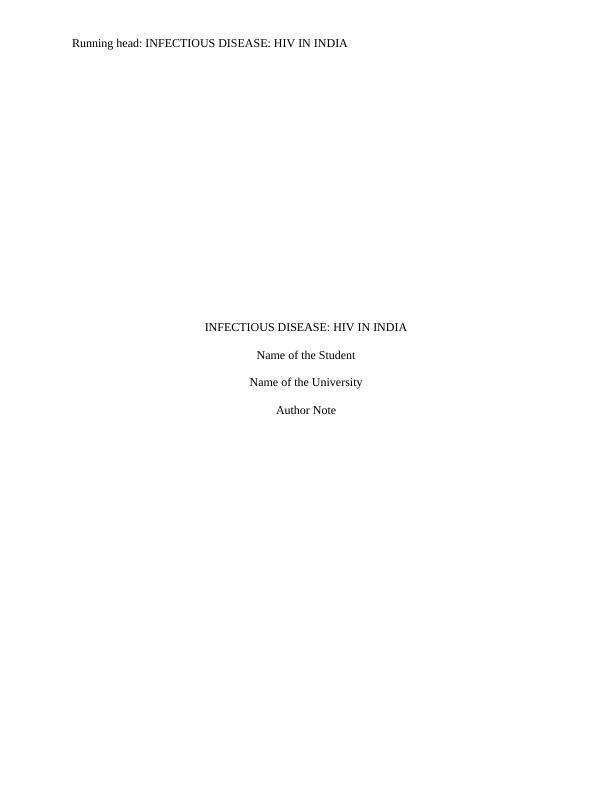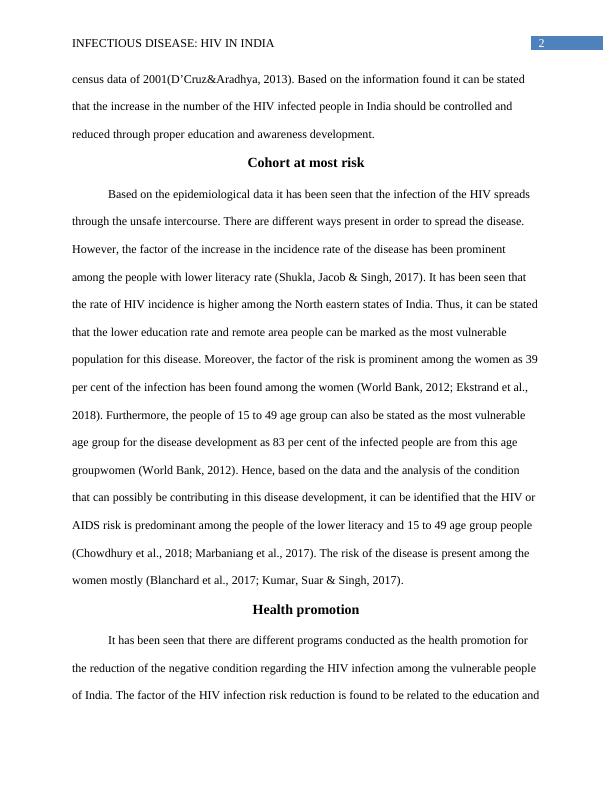Infectious Disease - HIV in India
10 Pages2380 Words12 Views
Added on 2022-08-19
Infectious Disease - HIV in India
Added on 2022-08-19
ShareRelated Documents
Running head: INFECTIOUS DISEASE: HIV IN INDIA
INFECTIOUS DISEASE: HIV IN INDIA
Name of the Student
Name of the University
Author Note
INFECTIOUS DISEASE: HIV IN INDIA
Name of the Student
Name of the University
Author Note

1INFECTIOUS DISEASE: HIV IN INDIA
Introduction
Sexually transmitted infections are developed through the unprotected intercourse and
most commonly transmits the human immunodeficiency virus or HIV. This virus attacks the
immune system of the affected human body and leads to develop different life threatening
infections or diseases including specific cancers if left untreated. This condition can be termed as
AIDS. It has been seen that approximately 37.9 million adults worldwide are affected by the HIV
virus which is 0.8 per cent of the total world population (World Health Organization, 2020;
Paranjape & Challacombe, 2016). The situation regarding HIV can vary in different countries of
world. In the following section, the epidemiological data of the HIV of Indian population, the
cohort at most risk population will be identified and the health promotion strategies used to
reduce the negative situation will be discussed.
Epidemiology
Statistical factor of the HIV affected population of India showed that approximately 2.4
million are affected with the HIV virus(World Bank, 2012). The prevalence rate of the virus is
0.31 per cent in 2009(World Bank, 2012). On the other hand, the data showed also that among
total infected 3.5 per cent are children whereas, 83 per cent of people are in the age group of 15
to 49(World Bank, 2012; Potty, Sinha, Sethumadhavan, Isac & Washington, 2019). On the other
hand, the 39 per cent HIV infected people are women(World Bank, 2012). Hence, based on this
data it can be clearly stated that the sexually transmitted disease rate is higher among the Indian
population rather than other possible causes of HIV infection (Ganju & Saggurti, 2017).
Moreover, it can be found that the process of the infection spreading is increasing or
uncontrolled among the Indian population as the health literacy regarding the disease is found to
be below average rate. The literacy rate of India has been seen to be 65 per cent, as per the
Introduction
Sexually transmitted infections are developed through the unprotected intercourse and
most commonly transmits the human immunodeficiency virus or HIV. This virus attacks the
immune system of the affected human body and leads to develop different life threatening
infections or diseases including specific cancers if left untreated. This condition can be termed as
AIDS. It has been seen that approximately 37.9 million adults worldwide are affected by the HIV
virus which is 0.8 per cent of the total world population (World Health Organization, 2020;
Paranjape & Challacombe, 2016). The situation regarding HIV can vary in different countries of
world. In the following section, the epidemiological data of the HIV of Indian population, the
cohort at most risk population will be identified and the health promotion strategies used to
reduce the negative situation will be discussed.
Epidemiology
Statistical factor of the HIV affected population of India showed that approximately 2.4
million are affected with the HIV virus(World Bank, 2012). The prevalence rate of the virus is
0.31 per cent in 2009(World Bank, 2012). On the other hand, the data showed also that among
total infected 3.5 per cent are children whereas, 83 per cent of people are in the age group of 15
to 49(World Bank, 2012; Potty, Sinha, Sethumadhavan, Isac & Washington, 2019). On the other
hand, the 39 per cent HIV infected people are women(World Bank, 2012). Hence, based on this
data it can be clearly stated that the sexually transmitted disease rate is higher among the Indian
population rather than other possible causes of HIV infection (Ganju & Saggurti, 2017).
Moreover, it can be found that the process of the infection spreading is increasing or
uncontrolled among the Indian population as the health literacy regarding the disease is found to
be below average rate. The literacy rate of India has been seen to be 65 per cent, as per the

2INFECTIOUS DISEASE: HIV IN INDIA
census data of 2001(D’Cruz&Aradhya, 2013). Based on the information found it can be stated
that the increase in the number of the HIV infected people in India should be controlled and
reduced through proper education and awareness development.
Cohort at most risk
Based on the epidemiological data it has been seen that the infection of the HIV spreads
through the unsafe intercourse. There are different ways present in order to spread the disease.
However, the factor of the increase in the incidence rate of the disease has been prominent
among the people with lower literacy rate (Shukla, Jacob & Singh, 2017). It has been seen that
the rate of HIV incidence is higher among the North eastern states of India. Thus, it can be stated
that the lower education rate and remote area people can be marked as the most vulnerable
population for this disease. Moreover, the factor of the risk is prominent among the women as 39
per cent of the infection has been found among the women (World Bank, 2012; Ekstrand et al.,
2018). Furthermore, the people of 15 to 49 age group can also be stated as the most vulnerable
age group for the disease development as 83 per cent of the infected people are from this age
groupwomen (World Bank, 2012). Hence, based on the data and the analysis of the condition
that can possibly be contributing in this disease development, it can be identified that the HIV or
AIDS risk is predominant among the people of the lower literacy and 15 to 49 age group people
(Chowdhury et al., 2018; Marbaniang et al., 2017). The risk of the disease is present among the
women mostly (Blanchard et al., 2017; Kumar, Suar & Singh, 2017).
Health promotion
It has been seen that there are different programs conducted as the health promotion for
the reduction of the negative condition regarding the HIV infection among the vulnerable people
of India. The factor of the HIV infection risk reduction is found to be related to the education and
census data of 2001(D’Cruz&Aradhya, 2013). Based on the information found it can be stated
that the increase in the number of the HIV infected people in India should be controlled and
reduced through proper education and awareness development.
Cohort at most risk
Based on the epidemiological data it has been seen that the infection of the HIV spreads
through the unsafe intercourse. There are different ways present in order to spread the disease.
However, the factor of the increase in the incidence rate of the disease has been prominent
among the people with lower literacy rate (Shukla, Jacob & Singh, 2017). It has been seen that
the rate of HIV incidence is higher among the North eastern states of India. Thus, it can be stated
that the lower education rate and remote area people can be marked as the most vulnerable
population for this disease. Moreover, the factor of the risk is prominent among the women as 39
per cent of the infection has been found among the women (World Bank, 2012; Ekstrand et al.,
2018). Furthermore, the people of 15 to 49 age group can also be stated as the most vulnerable
age group for the disease development as 83 per cent of the infected people are from this age
groupwomen (World Bank, 2012). Hence, based on the data and the analysis of the condition
that can possibly be contributing in this disease development, it can be identified that the HIV or
AIDS risk is predominant among the people of the lower literacy and 15 to 49 age group people
(Chowdhury et al., 2018; Marbaniang et al., 2017). The risk of the disease is present among the
women mostly (Blanchard et al., 2017; Kumar, Suar & Singh, 2017).
Health promotion
It has been seen that there are different programs conducted as the health promotion for
the reduction of the negative condition regarding the HIV infection among the vulnerable people
of India. The factor of the HIV infection risk reduction is found to be related to the education and

End of preview
Want to access all the pages? Upload your documents or become a member.
Related Documents
Epidemiological Study On Hiv Infectionlg...
|12
|2992
|15
Analysis of Community Outbreak of HIV/AIDSlg...
|5
|802
|466
Ebola Infection - Epidemiological Factorslg...
|12
|1099
|43
(PDF)Nursing - Assignmentlg...
|9
|2583
|91
[PDF] The global epidemiology of tuberculosislg...
|9
|2583
|105
World Health Organization (WHO) Defines Epidemiologylg...
|13
|3676
|133
